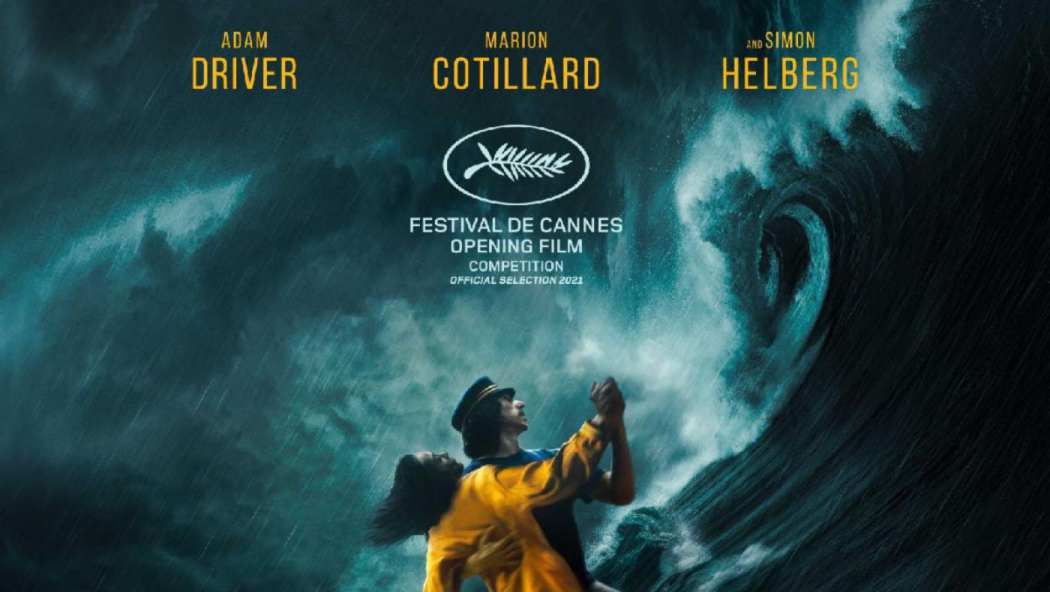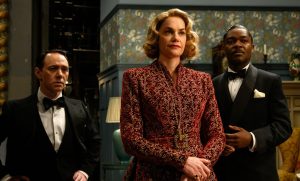


“We love each other so much,” sing Adam Driver‘s Henry and Marion Cotillard‘s Ann as they ride together on a motorcycle through the night in Leos Carax‘s new film, Annette (2021). This song, in addition to being the film’s catchiest tune, is indicative of the kind of musical that Carax and his collaborators from the band Sparks – who have co-written the screenplay with the increasingly elusive cinéma du look filmmaker – have set out to make: a musical of descriptive expressiveness rather than emotional substance. It’s a delicate balancing act that traipses intermittently through inspiration and banality, but the cast renders the film compelling throughout.
Like Romeo and Juliet, two disparate individuals are established as star-crossed lovers – who, as celebrities, live up to the celestial notion of stars. On one hand is Henry McHenry (Adam Driver), a popular comedian who is on the rise with his “mildly offensive” humor and onstage antics; and on the other, the fantastically popular opera singer Ann Defrasnoux (Marion Cotillard). Together, their romance is the subject of tabloid exposés thanks to the ever-watchful gaze of the paparazzi. Outside of the limelight, they have a relationship that is haptic in its interest in tickling and making love, but there is little that is dramatically offered to justify their union beyond biology. He is a man, she is a woman, and they bring into the world a child of their own named Annette. Predictably, and disappointingly so, the birth of Annette is when the story begins to shift as Henry succumbs to alcoholism and destructive behaviors that were never hinted at prior to being abruptly introduced. This is a fairytalelike shift comparable to the one in Carax’s Pola X (1999), which has a well-off character dramatically drift into abject poverty, but even that occurs over a distinct period of time. Annette is a film in which characters are only what they say they are, and they should largely be trusted as there is little room for lies in such a film.
Except, perhaps, for media-inspired nightmares! This is best realized in the use of a wooden marionette puppet to represent the child of Henry and Ann. As a child, Annette is something that her parents project their hopes and dreams onto. She is not herself, at least as an infant, but rather something that can be shaped and whittled down into anything. Her conditioning as a child to the life of performers soon takes on a more haunting quality, but that’s largely because of the nature of who we are told Henry is as opposed to who we see he is. It’s telling – or more precisely, singing – rather than showing.
There are moments of grand gestures and subtle realizations of the heart, but they are delivered on a foundation of description before they are allowed to stand on their own as affecting drama. The lyrics become a stand-in for the actual application of the words sung by all involved, and the frustrating brilliance of this is what it allows Annette to focus upon, while choosing not to adhere to, the idea of “entertaining” an audience in the theatrically-conventional sense.

The opening track, “So May We Start,” is a song that introduces the essence of the self-aware storytelling that is about to transpire, but it doesn’t prepare the audience for the use of repetition in lieu of nuanced lyrics that will convey the heart and soul of Annette. From the lyrics alone, there is only the shell of a soul, and yet Annette itself, lensed by Caroline Champetier, is a highly-accomplished work in a way that Carax’s previous film from nine years ago, Holy Motors (2012), is not. While cinema followers may admire the self-reflexive themes in Holy Motors, a film that laments the loss of a cinema that once was while searching for the cinema that could be, Annette is instead a film that is filled with flourishes bearing little purpose that evoke what Carax was once celebrated for: a playful mastery of film language. Staggered, slow-motion shots of Henry swinging his microphone, the beauty of a motorcycle going down the highway by starlight, or the superimposing of images over the road all remind us of Carax’s knack for visual storytelling, and yet this is a film of words. The presence of a scene with the theatrical dimming of the lights, as with the birth of baby Annette, is particularly powerful, and it’s the kind of thing that draws attention to the artifice of cinema as well as its use of theatre tradition. Still, such a scene is in service of a script that requires something like the dimming of lights to set it apart. The cinematic devices utilized by Carax and company become a counterpoint of sorts to the script, but the script is the guiding light of the whole endeavor.
Thankfully, the film is supported by Adam Driver, who can almost single-handedly sell that he’s telling the audience “we love each other so much” instead of ever truly having to show it. Driver’s singing voice is uniquely deep and pleasant to the ear, and he brings an intensity to the role of Henry that implies signifiers for the behavior that is attributed to his character in song alone. With less screen time, Simon Helberg also leaves a strong impression as the accompanist for Ann’s performances. At one point, the camera is spinning around Helberg’s character as he conducts the orchestra while telling us, the audience, about how he fits into this whole story, and it is one of the crowning achievements in Annette both dramatically and aesthetically. The redness around Helberg’s eyes and the ferocity of his conducting are over the top, to be sure, but they convey – in conjunction with the carefully-choreographed camera movement – a plot point that would otherwise fall flat were it delivered as nonchalantly as the rest of the film’s drama.
While fans of the musical number with Kylie Minogue in Holy Motors may be intrigued by the prospect of a full musical by Carax, the result is something far less interesting than it should be. Carax has always been a musically-inclined filmmaker, from the Bowie songs in Boy Meets Girl (1984) and Mauvais sang (1986) to the continuous-shot instrumental interlude in Holy Motors, but Annette struggles to feel cohesive as the story gets in the way and slows itself down. Were the lyrics more dynamic, perhaps Annette would rise above the feeling that all of this has been sung before, but at least we are left with the form of a stylish musical that has the courage to be frank about love.
